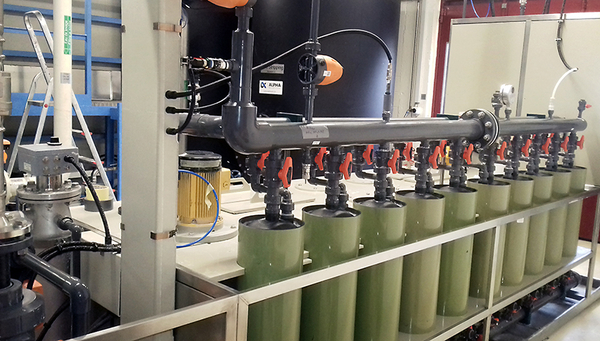News Detail
Climate tax finances energy-positive plants for water treatment
April 30, 2018 |
A major nutrient in wastewater is nitrogen, which in large quantities can cause great damage to our bodies of water. On the other hand, it is a valuable resource, a nutrient, which when recovered from wastewater can be used anew in agriculture. The nutrient cycle is thus completed and from the wastewater - perceived as an unwanted product - comes a major component of fertilizer. In order to recycle nitrogen, biological processes have always proved very successful, but in suboptimal operating modes they are weak in process stability and emit nitrous oxide, which is harmful to the environment. In use for a long time is the technology of air stripping. This procedure, with an innovative pre-treatment, is used on a large scale in the wastewater-treatment plant (ARA) in Kloten/Opfikon, with the support of Eawag. This process has, to be sure, been used in various water-treatment plants, but has not been widely disseminated because of high cost.
Present-day wastewater technology concerns itself with the very promising membrane-stripping method. Eawag researchers have already gained experience with semi-technical pilot installations in the ARA Neugut. Based on these early activities, the EU project POWERSTEP began in 2015, also with the participation of Eawag. As part of this project, process engineers worked under Marc Böhler to plan the first fully technical membrane-stripping installation and its implementation with industrial partners. This installation should be in place at the ARA Altenrhein on Lake Constance in 2018, while another fully technical membrane-stripping installation for nitrogen recovery is located at the ARA Yverdon in western Switzerland. The installation in Yverdon, in use since mid-2016, has enabled Eawag to gather worthwhile parameters about energy and equipment use in its POWERSTEP project.
The project will come to an end in May 2018 at the IFAT in Munich, the leading international trade fair for water, sewage, waste and raw-materials management. Other innovative technologies of the POWERSTEP project that have been tested on a large scale will also be introduced. These will make our wastewater treatment plants energy-positive in the future.
Improving CO2 emissions of the ARA
The experience gained in Yverdon and the operative figures now flow into the realization of the installation at the ARA Altenrhein. Part of the financing will come from the “Klimarappen” (climate tax), because the CO2 emissions of the ARA can be massively improved by the new membrane-stripping installation. The biological process previously used for nitrogen recycling produced nitrous oxide, harmful to the climate, as a by-product. Membrane stripping is the first process that emits no nitrogen oxide. This positive effect has led to support by the Climate Cent, a Swiss business foundation dedicated to effective climate protection. The foundation’s earnings were generated by a levy of 1.5 cents per litre on petrol and diesel imports from 2006 to 2012.
At the Info day 2018 on the theme “Waste Water as a Resource – trend-setting technologies for the recovery of recyclable waste“, Eawag employees and external experts will present lectures on various aspects of the recycling economy and resource recovery. In the future, new technical processes should help to protect and recycle natural resources and also to reduce negative effects on mankind and the environment.

